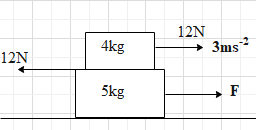
A block of mass 4 kg is placed on another block of mass 5 kg and the block B rests on a smooth horizontal table. If the maximum force that can be applied on A so that both the blocks move together is 12N, find the maximum force that can be applied on B for the blocks to move together.
A. 30N
B. 25N.
C. 27N
D. 48N
Answer
509k+ views
Hint: To solve this question first find the acceleration of the blocks when we apply a force on the block A. The highest frictional force between the blocks becomes 12 N. Using these data, balance the forces and find the maximum forces that can be applied on the block A.
Complete answer:
Given in the question that the mass of the box A is ${{m}_{A}}=4kg$
The mass of the block B is ${{m}_{B}}=5kg$
The minimum force that can be applied to block A so that both the blocks move together is 12 N.
Now, when we apply a force on the block A, a frictional force will act between the surface of the block A and block B. frictional force is a force which opposes the motion of a body and the limiting friction is a force which is the maximum frictional force between two surface and at the limiting friction the body will move.
The acceleration of the block A will be,
$a=\dfrac{F}{{{m}_{A}}}=\dfrac{12N}{4kg}=3m{{s}^{-2}}$
Now, when we apply force on the block B, then also the frictional force will act between the two bodies. This frictional force will also be maximum at 12 N force.

So, when we subtract the frictional force between the two bodies from the force applied on block B, we will get the mass of block B times the acceleration.
$\begin{align}
& F-12=5\times 3 \\
& F-115 \\
& F=27N \\
\end{align}$
So, the maximum force that can be applied on block B so that both the blocks move together is 27N.
The correct option is (C).
Note:
When one block is on the above of each other, the two blocks will move along with each other when we apply a force only in one block to a certain extent because of the friction force between the blocks. If friction does not exit the block on which force is not applied will move opposite to the motion of the block on which force is applied.
Complete answer:
Given in the question that the mass of the box A is ${{m}_{A}}=4kg$
The mass of the block B is ${{m}_{B}}=5kg$
The minimum force that can be applied to block A so that both the blocks move together is 12 N.
Now, when we apply a force on the block A, a frictional force will act between the surface of the block A and block B. frictional force is a force which opposes the motion of a body and the limiting friction is a force which is the maximum frictional force between two surface and at the limiting friction the body will move.
The acceleration of the block A will be,
$a=\dfrac{F}{{{m}_{A}}}=\dfrac{12N}{4kg}=3m{{s}^{-2}}$
Now, when we apply force on the block B, then also the frictional force will act between the two bodies. This frictional force will also be maximum at 12 N force.

So, when we subtract the frictional force between the two bodies from the force applied on block B, we will get the mass of block B times the acceleration.
$\begin{align}
& F-12=5\times 3 \\
& F-115 \\
& F=27N \\
\end{align}$
So, the maximum force that can be applied on block B so that both the blocks move together is 27N.
The correct option is (C).
Note:
When one block is on the above of each other, the two blocks will move along with each other when we apply a force only in one block to a certain extent because of the friction force between the blocks. If friction does not exit the block on which force is not applied will move opposite to the motion of the block on which force is applied.
Recently Updated Pages
Why are manures considered better than fertilizers class 11 biology CBSE

Find the coordinates of the midpoint of the line segment class 11 maths CBSE

Distinguish between static friction limiting friction class 11 physics CBSE

The Chairman of the constituent Assembly was A Jawaharlal class 11 social science CBSE

The first National Commission on Labour NCL submitted class 11 social science CBSE

Number of all subshell of n + l 7 is A 4 B 5 C 6 D class 11 chemistry CBSE

Trending doubts
What is meant by exothermic and endothermic reactions class 11 chemistry CBSE

10 examples of friction in our daily life

One Metric ton is equal to kg A 10000 B 1000 C 100 class 11 physics CBSE

1 Quintal is equal to a 110 kg b 10 kg c 100kg d 1000 class 11 physics CBSE

Difference Between Prokaryotic Cells and Eukaryotic Cells

What are Quantum numbers Explain the quantum number class 11 chemistry CBSE




